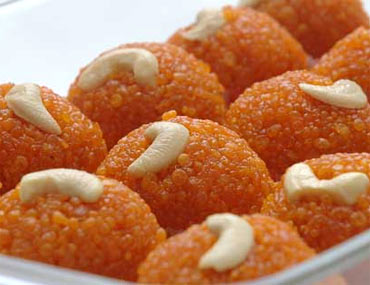This article was first published 14 years ago
Puran, Alu Wadi and more Ganesha recipes!
Last updated on: September 5, 2011 18:53 IST
Image: Kadabu
Ladies from across the country share their household recipes that mark the Ganesha festival.
With Ganesha celebrations underway, all of us are busy with last-minute preparations. Buying decorations, cleaning the house, getting the idol home etc...there's no end to it. Till the Lord leaves for his final ocean abode, the festivities don't stop.
Rich food and sweets are synonymous with all Indian festivals and Ganesha is believed to be particularly fond of laddoos and modaks. Even though many of us don't bring the idol home, we all love to savour and relish the traditional preparations.
We asked a few ladies who celebrate the festival to share their best recipes with us. It is interesting to observe how distinguished by languages but amalgamated by the Lord, flow in the festive fervor to celebrate Ganpati in their own unique way.
Swati Kulkarni, nutritionist
We install both the Ganpati and Gauri idols at our place and immerse them together on the sixth day, ie Gauri Visarjan.
The idols are placed beside each other and a lamp (deep) is lit next to them continuously for the six days. We abstain from using thermocol or real flowers for decoration to maintain the eco-friendly spirit of the festival and use recycled paper and artificial flowers instead.
Everyday, different sweets and dishes are prepared for the Lord. The fourth day, ie the second day of Gauri, is very important. It is on this day that we prepare a lot of delicacies referred to as Panch Pakvaan. Different aartis for Gauri and Ganpati are recited every morning and evening for all six days. After the aarti, prasad in the form of sweets and snacks is distributed among friends and family.
Kadabu
Ingredients:
For the covering:
- 3/4th portion refined flour (maida)
- 1/4th portion rawa
- A pinch of salt
- Water
- Oil
For the filling:
- 2 cups sugar
- 2 cups shredded jaggery
- 2 tsps roasted poppy seeds (khus khus)
- 1/2 tsp cardamom powder (elaichi), raisins (kishmish)
- 1/4 cup raisins, cashewnuts, pistachios, sugar crystals (mishri)
- 2 tbsps ghee
Method:
- Mix all the ingredients for the covering together. Add oil and water and knead it into stretchy and smooth dough. Set aside.
- Heat ghee in a pan on medium flame and add coconut and jaggery.
- Stir continuously till the jaggery melts and mixes with the coconut.
- Add khus khus, elaichi powder and raisins. Mix everything well and take it off the heat.
- Take the dough made for the covering and roll it into circles of 3" diameter.
- Put a spoon of filling in each circle and fold it to a half-moon shape. Use a little water to seal the edges.
- Keep all these aside covered with a damp cloth.
- Take oil in a pan and deep-fry on medium flame until brown and crispy.
- Serve hot or cold.
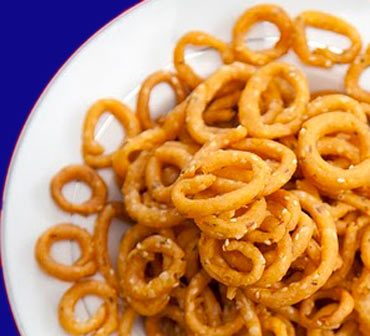
Image: Kadboli
Swati also shared this recipe for Kadboli:
Ingredients:
- 1/2 cup bajra
- 1 cup rice
- 1 cup jowar
- 1/2 cup urad dal
- 2 tbsps coriander seeds (dhaniya)
- 2 tbsp cumin seeds (jeera)
- 1 tbsp red chilly powder
- 2 tbsps sesame seeds (til)
- 1/4 cup heated oil
- Salt to taste
- Oil for deep-frying
Method:
- Roast bajra, rice, jowar, urad dal, dhaniya and jeera separately.
- Mix them all together and grind into a fine dry powder.
- Add salt, til, chilly powder and heated oil. Combine it into a smooth dough by adding lukewarm water. Keep it aside for an hour covered with a muslin cloth.
- Take small pieces of dough and roll between your palms so that it resembles a small pencil. Join both the ends together to form a circle.
- Take oil in a pan and deep-fry on a medium flame till the rolls turn brownish-gold. Drain the excess oil and let them cool.
- The Kadboli can be eaten immediately or stored in an air-tight container.
Image: Churme ke Laddoo
Anjali Relan, stock market consultant
As both my husband and I are working and there are no in-laws to look after the idol, for us it's only feasible to install it for one and a half days. Most importantly, the entire 'cleansing of the house' begins around a month in advance to prepare for the Lord's welcome.
The sthapna (installation) is done at 6 or 7 am in the morning by a priest who performs all the rituals. A half hour-long aarti and puja follows. As Ganpati is fond of sprouts, all kinds of dishes with various sprouts like chickpeas, moong dal, beans etc are prepared and offered to the Lord as bhog.
On the second day, we perform the Satyanarayan Katha at our place and call our family and friends. Various Gujarati and Maharashtrian sweets and dishes are prepared and offered to the Lord and distributed amongst everyone as prasad.
Churme ke Laddoo
Ingredients:
- 2 cups whole wheat flour (atta)
- 4 tbsps ghee
- 1 tsp elaichi (cardamom) powder
- 1/2 cup sugar
- 1/2 cup jaggery
- 2 tbsps powdered mixture of raisins and nuts (almonds, cashews, pistas)
- Oil
Method:
- Knead the atta into a stiff dough using the water.
- Make small balls from the dough. Roll out each ball into a small 12 cm-long disc.
- Take oil in a pan and fry the discs till brown and crispy.
- Crush these and make them into a fine powder.
- Take ghee in a pan and add sugar, jaggery, raisins, nuts and elaichi powder.
- Add the crushed atta mixture to the pan and heat it on low flame for two minutes.
- Grease your hands with oil and make this mixture into small balls. Serve hot or cool.
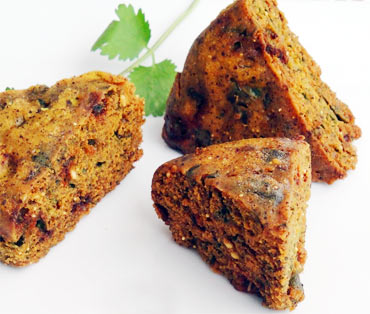
Image: Kothimbir Vadi
Vinita Gujar, financial consultant
We keep the Lord at our place for the whole 10 days, with the visarjan (immersion) on the eleventh day.
Celebrations begin technically two to three months prior, with the booking of the Ganpati idol. A day before Bappa's arrival the whole house is decorated with rangoli and flowers. A pandit is called to install the idol at a pre-decided auspicious time (mahurat).
Aarti is done twice a day along with the recital of Ganpati Stotra. Two different offerings are made to the Lord in the morning and evening, which are later distributed as prasad. On the first day and last day a 'Naivedya Bhog', consisting of 21 laddoos and 21 modaks is prepared and offered to the Lord.
Kothimbir Vadi
Ingredients:
- 3 bunches of coriander/dhaniya (washed, dried and finely chopped)
- 1 cup gram flour (besan)
- 1 tsp chilly powder
- 1 tsp haldi powder (turmeric)
- 1/4 tsp baking soda
- Oil
- Salt to taste
- 1 tsp garam masala
Method:
- Mix besan, finely chopped dhaniya leaves, chilly powder, haldi powder, baking soda, salt and garam masala together. Add a little water till the whole mixture becomes a thick paste.
- Add two tbsps heated oil to the paste.
- Grease a vessel and evenly spread the paste into it. Then steam for 15 minutes in a pressure cooker without the whistle on.
- Remove and cool it. Cut into square pieces.
- Take oil in a pan and deep-fry or shallow-fry the square pieces.
- Serve hot with green chutney or tomato ketchup.
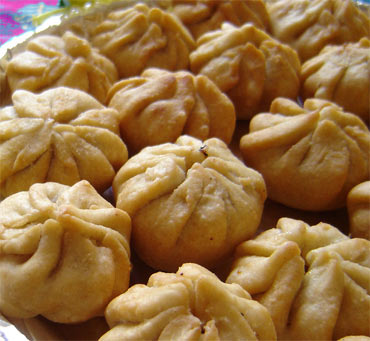
Image: Deep-Fried Modak
Vinita also offered up this Deep-Fried Modak preparation:
Ingredients:
For the filling:
- 2 cups grated coconut
- 2 cups grated jaggery
- 2 spoons shredded cashewnuts (kaju)
- 2 spoons raisins (elaichi)
- 2 spoons shredded pistachio nuts (pista)
- 2 spoons grated almonds(badam)
- 1 tsp cardamom powder
- 1/4 cup ghee or butter
For the covering:
- 2 cups whole wheat flour (atta)
- Water
- Oil
- A pinch of salt
Method:
- Combine all the ingredients for the covering and knead into a stretchy, smooth dough. Set aside.
- Heat ghee in a pan and add all the dry fruits to it.
- Mix with coconut and jaggery.
- Continue cooking over medium heat while stirring occasionally.
- After the jaggery melts and mixes with the coconut, mix it well by adding cardamom powder to it.
- Divide the dough into small balls. Take each ball and roll it into a circle of 3" diameter.
- Add a little filling mixture in the centre of each circle of dough and seal from all sides at the top, by joining all the edges together and giving them a slight twist.
- Heat oil in a pan and deep-fry the modaks on medium heat till they become brown and crisp.
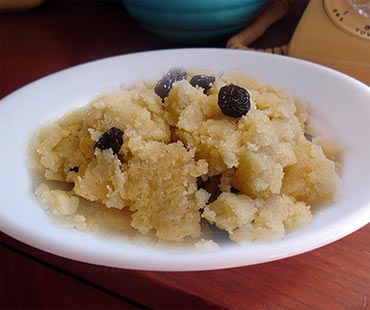
Image: Sooji Ka Halwa
Meenakshi Bhatia, beauty salon owner
As we are Sindhis, we generally follow what the Maharashtrians do and fuse it with our tradition. This is done basically so that we celebrate the festival in our way and also don't go wrong anywhere with the traditional rituals. Our Ganpati festival, hence, is an assimilation of two languages and ethnicities.
We keep the Ganpati for one and a half days. The idol is booked 15 days prior to the festival and the house is adorned with festoons and flowers one day prior to Ganesh Chaturthi. As for sweets and snacks, we don't prepare the traditional Maharashtrian dishes, but make simple yet different sweets on both days as prasad.
Sooji Ka Halwa
Ingredients:
- 1 cup sooji/rawa
- 2 tbsps ghee
- 1 cup milk
- 3/4 cup sugar
- 1 tsp elaichi powder (cardamom)
- 8-10 raisins
- 1 cup water
- 10-12 cashews and almonds (chopped)
Method:
- Take ghee in a pan, heat it and then add sooji. Roast it til the colour changes to slightly light brown. Remove from flame and keep aside.
- Mix water, milk, sugar, elaichi, raisins together and put to boil.
- Add the roasted sooji and stir till blended well.
- Garnish with almonds and cashewnuts and serve hot.
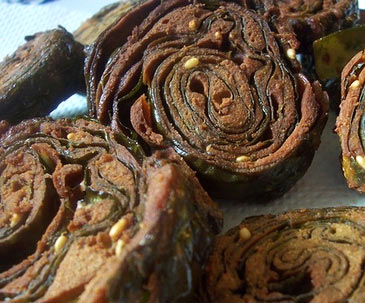
Image: Alu Wadi/Patode
Smita Anikhinde, housewife
Ganpati is installed in our house for five days. The Lord is brought into our house one day before Ganesh Chaturthi.
Decorations and other materials are bought almost a week prior after consulting a priest, who also decides where in the house he should be placed. It is we who have to ensure that the Lord remains unmoved for five days.
Every year, we have to either increase the price of the idol or its size. The former usually happens automatically! After the sthapana (installation) we perform the pran pratishtha puja. Different sweets of different varieties are presented to the Lord everyday and his blessings are mercifully sought.
Alu Wadi/Patode (Taro leaf spirals)
Ingredients:
- 10-12 alu leaves (known as elephants ears)
- 1 1/4 cup besan (gram flour)
- 1 tsp chilly powder
- 1/2 tsp turmeric powder
- 1/4 tsp mild heeng
- Tamarind juice (made by soaking a little tamarind in half a cup of water for 20 minutes. Mash and filter it. The filtered water will yield the juice).
- 1 tbsp til seeds (sesame seeds)
- 1 tsp oil
- Salt to taste
Method:
- Apart from the alu leaves, mix all the above ingredients to make a semi-liquid paste of flowing consistency.
- Trim the stems off the leaves and wash them.
- Remove a thin layer from the central rib of the leaves to make them more supple for rolling.
- Spread the paste across the whole length of the upturned leaf (rib-side up) using an upturned thali. Place another leaf on top of this leaf and put more paste. Do this with 3-4 leaves to get a generous-sized roll.
- Fold the leaves over the sides and roll them as tightly as possible to form a cylindrical log. Place these logs in a pressure cooker and steam them for 30-40 minutes without putting the whistle on.
- Cool the logs and cut them into small thick circles.
- Take peanut oil in a kadhai and deep-fry till they turn medium-brown in colour.
- Drain the excess oil with tissues and serve with coconut chutney or ketchup.
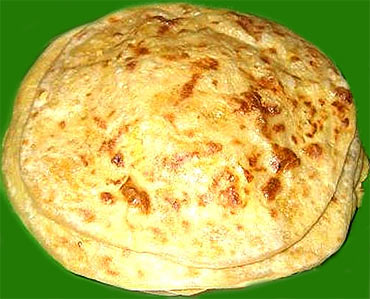
Image: Puran
And here is Smita's recipe for Puran:
Ingredients:
- 2 cups chana dal (soaked in water overnight)
- 2 cups jaggery
- 2 cups refined flour (maida)
- 3 tbsps oil
- 1/4 tsp freshly grated nutmeg powder (jaiphal)
- 3/4 tsp turmeric powder (haldi)
- 1 tbsp saffron (kesar)
Method:
- Soften the chana dal by cooking it in a pressure cooker. Strain off the excess water and crush to dry out the dal completely.
- Add jaggery and cook it further till it becomes a soft paste.
- Add elaichi, kesar, grated jaiphal and mix well to make a soft and sticky mixture.
- The puran can be used as bhog for the Lord, eaten as a sweet or used to make laddoos. It can also be put in kneaded dough and eaten as puran poli.


